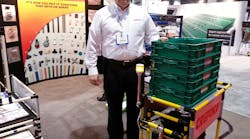move along a designated route, possibly towing carts of parts for delivery to assembly processes. There were several such displays at last week’s MODEX 2014 show in Atlanta. But while we’re fascinated by these things as overgrown kids, the idea of doing the homework to investigate buying and installing a system in one’s own operations tends to intimidate people. That’s what Creform’s vice president of sales, Keith Soderlund told me as I watched a guided cart traverse his booth. I must admit, though, his display seemed a bit more welcoming to the kid in us, with carts constructed of pieces of pipe fitted together to form whatever kind of material handling system we could imagine.
Soderlund was actually approached by one such kid-like attendee who happened to be in the mattress business. He imagined a giant cart built of Creform’s 42 mm diameter piping being towed along a production line, carrying a King-size mattress. As the two discussed this potential application, the intimidation factor gradually declined. Whether such a system will actually be built is yet to be determined, but suffice it to say, it COULD be.
Another aspect that tends to calm AGV jitters is the cost of such a basic system. Soderlund talked about AGV systems that can be up and running for as little as $10,000, starting at the base level with a drive unit that can travel multiple routes, guided by a magnetic tape path on the floor. Systems are already used in automotive plants such as GM.
Other guided vehicles on display were a bit more sophisticated, but it was apparent that the technology’s fear factor among warehousing professionals is starting to be addressed. Mark Longacre, marketing manager at JBT told me that AGVs are no longer confined to assembly plants. In fact warehousing applications have become 10% of JBT’s business. Key to that is standardization of system components. Longacre believes that will lead to more leasing of AGVs—just as forklifts are leased. With greater standardization, a vehicle’s residual value is protected. That will make such automation more attractive to third party logistics (3PL) service providers, whose need for flexibility to suit a variety of clients is well served by today’s AGVs, Longacre believes.In fact the leasing business model has grown to such an extent that JBT has a full time broker handling it for them. But for this to work on a broader scale, Longacre said system integrators will need better education in the concept and execution.
MODEX provided a good immersion into automated vehicles, tape-, laser- and vision-guided. In the latter class, several exhibitors demonstrated automated forklifts. Raul Bravo, president of Balyo, a Paris-based provider of forklift automation, is entering the American market with an eye on that 3PL market just mentioned. His company provides automated reach trucks guided by a proprietary navigation system. He says these can travel without drift for 6500 ft. He says warehousing is a more predictable environment, and that his company’s vehicles can provide an ROI in 12-18 months.
Of course there were American competitors sharing the MODEX floor, including Yale Materials Handling, which announced that its MO50T tow tractor can now be guided by Seegrid’s vision-guidance technology. Again, warehousing is a prime target here, with the vehicle’s ability to be used as an AGV or in manual operator mode coming in handy.
Seegrid displayed its own automated vehicle, the GWS35 walkie stacker, which can automatically pick up, drop, stack, and put away loads up to 72 inches at a maximum load capacity of 3,500 pounds.
Dave Blanchard and I tweeted about these and many other impressive sights and insights at MODEX. We thought the best way to share them with you again would be through a gallery. Click here to go there.









